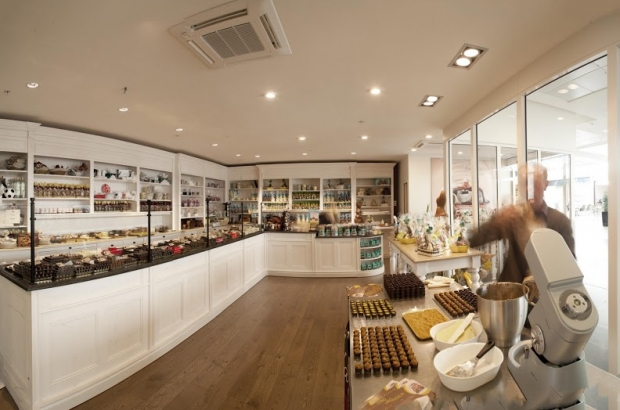Categories
Recent reviews
Valentino Chocolatier
Leen De Leener and Willy Roelandts have been making chocolate since 1978 when the couple took over a little artisanal shop in the Koekelberg commune of Brussels. Remaining a small family business, Valentino has developed into one of the country’s most highly reputed chocolatiers, with their products sold in more than 60 shops across Brussels and Flanders. In the 1990s the company moved its headquarters to Schepdaal, about five kilometres outside Brussels, where they make the products and maintain their own shop. A team of just 25 produces more than 300,000 kilos of pralines, chocolate bars and figures every year.
Despite more than 40% of the company’s sales coming from export (they sell to China, Chile and the UK, among other countries), the Valentino brand is still focused on its home market. Besides the shop in Schepdaal, they maintain shops in the Basilix shopping centre in Brussels and in nearby Halle. “We don’t have this exclusive, expensive reputation like so many of the more well-known Belgian brands,” says Rob Roelandts, son of the founders and Valentino’s very driven marketing manager. “But that’s our strong point. We’re respected for making a consistently good, high-quality product at an affordable price.”
I can only agree after I taste pralines fresh off the conveyor belt. During my visit, Valentino is gearing up for Valentine’s Day (the holiday that inspired its name), and most of the pralines to come off the line have some kind of love theme, from heart-shaped treats to chocolate-covered cherries. As I bite into a rectangular piece of milk chocolate decorated with a pair of bright red lips, my tongue is greeted by a heavenly hazelnut and crispy crêpe filling. The taste is divine, and I’m inspired to find out more about the chocolate-making process.
That’s where Valentino’s workshops come in. You can learn how to make your own pralines, under the friendly guidance of house chocolatiers Henk and Sven.
The pair start out by explaining the importance of tempering chocolate, which means heating it to the right temperature to reach the desired crystallisation. This is what gives melted chocolate its glossy, solid state after cooling.
Making pralines is a rather labour-intensive process, requiring you to fill a mould, scrape off the excess chocolate and allow to cool, then repeat three or four times. Then they show us how to fill a paper cone with coloured chocolate to use for decoration. This requires a steady hand and strong willpower (so as not to squeeze all the chocolate straight into your mouth). The workshop is fun and messy, and there’s a whole lot of finger-licking going on.
Groups of 10 or more are encouraged to sign up for a workshop, which usually take place on Saturday mornings and can be arranged in Dutch, English or French. It’s a great way to celebrate a special occasion with a group of friends. And the best part is, you get to take home the fruits of your labour. Or rather the chocolate.
But of course you can also just buy it. Valentino’s shops are filled with gift baskets and metres-long counters with more than 80 types of pralines.
Factory store: 1026 Chaussée de Ninove, Schepdaal
Concept stores: (Basilix) 420 Avenue Charles-Quint, Brussels & (Halle) 3 Beestenmarkt, Halle
This article was originally published in Flanders Today









